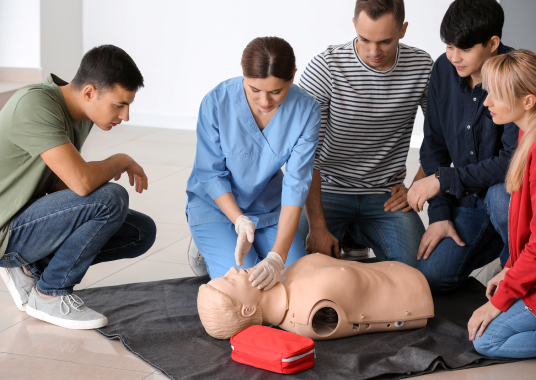CPR, First Aid, BLS, ACLS, PALS certifications.


Get certified in Adult, Child, and Infant CPR and First Aid with our 100% online combo course—complete it in just 2–3 hours and receive instant 2-year certification, unlimited quiz retakes, and a free mailed wallet card.
| Chapters | CE Credits | Validity | Cost | Duration | ECC | Exam Attempts | Wallet Card |
|---|---|---|---|---|---|---|---|
| 24 | 6.0 | 2 Years | $36.95 | 2-3 Hrs | Compliant | Unlimited | Download/Print/Mail |
The American Heart Association (AHA) and Emergency Cardiovascular Care (ECC) guidelines were updated in 2010, changing the traditional A-B-C order of CPR (Airway–Breathing–Compressions) to C-A-B: Compressions–Airway–Breathing. This change was made because compressions were often delayed with the A-B-C sequence. With the C-A-B method, compressions start immediately, getting vital blood flow to the brain and organs faster.
Here’s how the C-A-B approach works (we’ll cover each step in more detail in the next chapters):
With the rise of COVID-19, there were special updates to protect rescuers and reduce transmission risk—especially for laypeople who may not have access to personal protective equipment (PPE).
For children: Chest compressions are still recommended. Mouth-to-mouth can be considered. As with adults, covering both the rescuer’s and child’s nose and mouth is advised for non-household situations.
Updated CPR guidelines continue to recommend a compression rate of 100–120 per minute. Going faster or pressing too deep may reduce the heart’s ability to refill, and affect the outcome negatively.
Steady, controlled compressions are key to effective CPR.
Hands-Only CPR is meant for teens or adults who suddenly collapse. It’s especially useful when someone has been trained in CPR before but may not remember every detail.
Here’s what to do:
This chapter in your Online CPR/AED and First Aid Combo Course explains the C-A-B sequence and recent updates so you can respond confidently and safely in a real-life cardiac emergency.